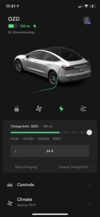ro_explorer
Member
This week I've done a looong trip (1500 Km) and I was curious to see the impact of the supercharging sessions over my poor, degraded battery ...Haven't wrote here in a while. I'm one of the unlucky when it comes to battery.
When it was brand new in June 2021, my LR 2021 had 79.1kwh reported in SMT. Now, 8 months and 20.000 km later SMT is showing 74.6 KWh as nfp. To me this looks like on the far left of the degradation distribution for model 3 fleet.
I charged at 80% most of the time, going above that only right before going on a long trip. 75% of time I've charged at AC stations, with few supercharger sessions in between.
Not all batteries are created equal.
I was in shock after seeing the numbers from SMT (I still am, in a good way):
What? When? How? Why? ... I was pretty convinced that from 74.6 will not bounce back more than 75 (which it did for a few weeks). Now, if this 77.1 value is correct, it means that my 9 months old, 24.000 Km Model 3 LR has only degraded 2.5% which is exactly spot-on as the expectations.
My question is, how the hell the BMS is not showing this value? For the past 2 months I charged randomly, AC only, not lower than 30% and only up to 70% .
This, combined with a mild spring weather, with temps hovering between 5 and 10 degreed Celsius.



